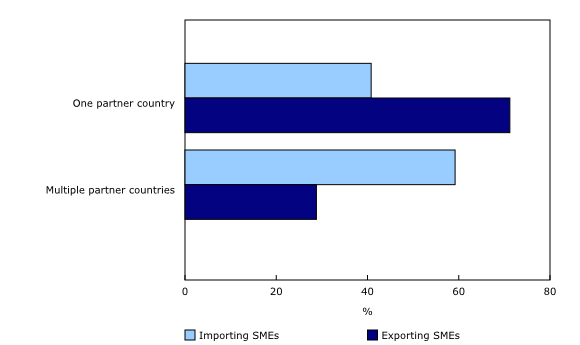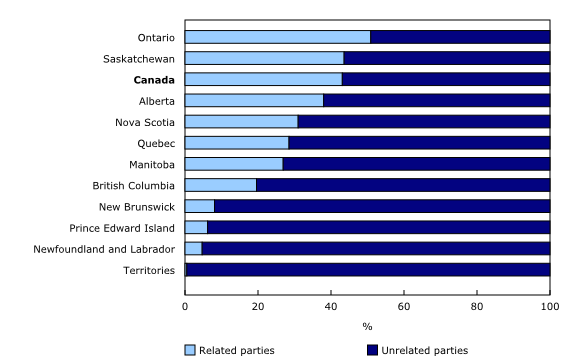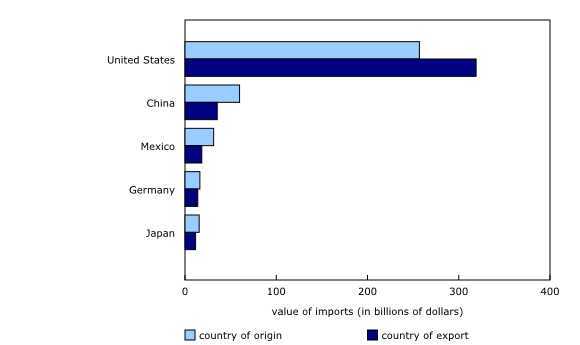Trade by Importer Characteristics – Goods, 2016
Archived Content
Information identified as archived is provided for reference, research or recordkeeping purposes. It is not subject to the Government of Canada Web Standards and has not been altered or updated since it was archived. Please "contact us" to request a format other than those available.
Released: 2018-03-13
In 2016, 148,886 Canadian enterprises imported $497.2 billion worth of goods. Small and medium enterprises (SMEs) accounted for 98.6% of all importing enterprises, but for less than half (46.7%) of total import values.
By comparison, the number of Canadian enterprises exporting goods was 43,255 in 2016. Similar to importers, SMEs accounted for 97.4% of all exporters in the country, while they were responsible for 40.8% of all export sales.
A small number of enterprises in the country were therefore responsible for a large proportion of the international merchandise trade activity. For example, the top 100 importing enterprises in Canada accounted for nearly half of total import values in 2016. Similarly, the top 100 exporting enterprises accounted for 56.6% of all export sales.
Consequently, the average value of imports and exports performed by SMEs and large enterprises differs greatly. In 2016, a single SME imported $1.6 million worth of goods on average, compared with an average import value of $130.8 million for a single large enterprise. The difference was even more pronounced on the export side, with an average export value of $4.3 million for a single SME exporter and $231.9 million for a single large enterprise.
In addition, the trading patterns of SME importers and exporters were quite different in terms of the number of trading partners they dealt with. Nearly 60% of all SME importers sourced goods from more than one country in 2016. In contrast, fewer than 30% of SME exporters shipped goods to more than one country.
The wholesale trade sector accounts for nearly half of all Canadian imports of goods
Importer characteristics can also be analyzed based on establishments in addition to enterprises. The establishment better reflects the primary industrial activity and the province of the importer. One enterprise can have multiple establishments operating in different provinces and industries.
The wholesale industry was responsible for the majority of imports from 2010 to 2016, followed by the manufacturing and the retail trade industries. In 2016, 30,940 establishments in the wholesale industry imported $235.9 billion worth of goods.
Overall, imports of goods declined by $4.7 billion in 2016 compared with 2015. Declines were reported in every province except Nova Scotia, Ontario and British Columbia. The largest decrease was in Alberta, where imports fell by $3.4 billion. The mining, quarrying and oil and gas extraction sector was the largest contributor to the decline, but the effect was moderated by an increase in imports from the construction sector. These changes reflected the impact of the wildfires in northern Alberta, followed by the rebuilding and repair efforts in this area.
A significant share of Ontario's imports are conducted between related parties
Imports can be presented based on the nature of the two parties involved in the transaction. If one party to the transaction holds 5% or more of the shares of the other party it is dealing with, the import is deemed to take place between related parties. This provides information on the extent of intra-firm trade in Canada's international trade activity and highlights the integrated nature of trade in a globalized environment.
More than two-fifths (43.1%) of all goods imported by Canadian enterprises were purchased from a related party located outside of Canada in 2016.
More than half of Ontario's imports in 2016 were conducted between related parties. Most of the related-party trade in Ontario took place in the wholesale industry, which accounted for 70.3% of the province's total related-party trade. Ontario's main products imported from related parties were motor vehicles, engines, telephones and substances used for medical treatment.
Import patterns differ depending on the country allocation of imports
On a geographical basis, imports can be allocated to the country in which the final stage of production or manufacture occurs (country of origin) or the last country from which the good was exported before entering the Canadian economy (country of export). Trade patterns differ depending on the country basis selected for the analysis.
On the country of export basis, Canadian enterprises imported $319.0 billion worth of goods from the United States in 2016. On the country of origin basis, the value of imports from the United States was lower at $256.9 billion. This activity reflects the movement of goods purchased by US companies from foreign countries and then sold to Canadian enterprises. These goods mainly included computer equipment, cellular devices and machine parts in 2016.
For China, imports by Canadian enterprises on the country of export basis totalled $35.3 billion in 2016, compared with a value of $59.8 billion on the country of origin basis. This, again, illustrates the movement of goods assembled or manufactured in China and purchased from another country before entering the Canadian economy. Cellular devices, computer equipment and toys were some of the most common commodities imported from China via another country in 2016.
Note to readers
The Trade by Importer Characteristics - Goods program is an initiative at Statistics Canada undertaken to analyze the business characteristics of importers of goods in Canada. These estimates are formed by linking customs merchandise trade data records to business entities in Statistics Canada's Centralized Business Register.
Customs import data are collected jointly by Statistics Canada and the Canada Border Services Agency.
The Business Register contains the complete operating and legal structure of enterprises operating in Canada, as well as their key characteristics such as employment and economic activity based on the North American Industry Classification System.
Survey definitions
This release contains information at both the enterprise and establishment levels. An enterprise is defined as the statistical unit that directs and controls the allocation of resources relating to its domestic operations, and for which consolidated financial statements are maintained. An establishment is the smallest statistical unit within an enterprise structure, and better reflects the primary industrial activity and the province of the importer. The two measures generate a different number of importing units, as well as a different industry allocation of these units.
Small and medium-sized enterprises have fewer than 500 employees, including those that did not report any employment. Large enterprises have 500 or more employees.
Country of origin is the country of production or the country in which the final stage of production or manufacture occurs.
Country of export is the country from which the goods were exported or sold to Canada. The country of export is different from the country or place of transshipment. Many goods which are shipped to Canada may stop at some place along their route to either change carriers, or to be consolidated or deconsolidated to make shipping easier. This type of stoppage is considered a transshipment point, but it will not change the country of export.
Domestic re-imports are goods of Canadian origin, whether grown, extracted, or manufactured in Canada, that are exported to another country and then returned to Canada in 'the same state' as they were sent out.
A related party is defined as a party that holds or controls 5% or more of the outstanding voting stock or shares of the other party it is transacting with.
In this release, data disseminated at the provincial level is conceptually different from customs-based merchandise import data. Provincial data for the Trade by Importer Characteristics program are based on the province where the importer is located, and goods can be shipped to other provinces for final consumption. Customs-based merchandise imports are based on the province of clearance; this is the province where the goods are cleared at customs, but this may not always be the province in which the importer is located.
Detailed information on concepts and methodology relating to this release is available on the Trade by Importer Characteristics program survey page.
Survey coverage
In this release, the total value of imports refers to the part of the annual import value (customs basis) that can be linked to specific entities in the Business Register each year. Annual import values (customs basis) can be obtained from CANSIM table 228-0060. Additional information and definitions related to merchandise imports are available on the survey page for Canadian International Merchandise Trade (Customs Basis).
Each year from 2010 to 2016, the total number of identified importing enterprises accounted for 93% to 96% of the total import value. Throughout this release, the percentage share of import value corresponds to the share of the annual import value for which there was an identified importer. The number of importers corresponds to the number of importers identified within the Business Register by the Trade by Importer Characteristics program.
Products
The Methodological Guide: Canadian System of Macroeconomic Accounts (13-607-X) is available.
The User Guide: Canadian System of Macroeconomic Accounts (13-606-G) is also available. This publication will be regularly updated to maintain its relevance.
Contact information
For more information contact us (toll-free 1-800-263-1136; 514-283-8300; STATCAN.infostats-infostats.STATCAN@canada.ca)
To enquire about the concepts, methods or data quality of this release, contact Angela Yuan-Wu (613-240-2871; angela.yuanwu@canada.ca) or Michelle Fong (613-293-8924; michelle.fong@canada.ca), International Accounts and Trade Division.
- Date modified:




